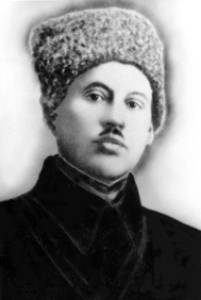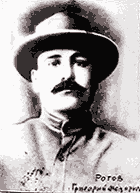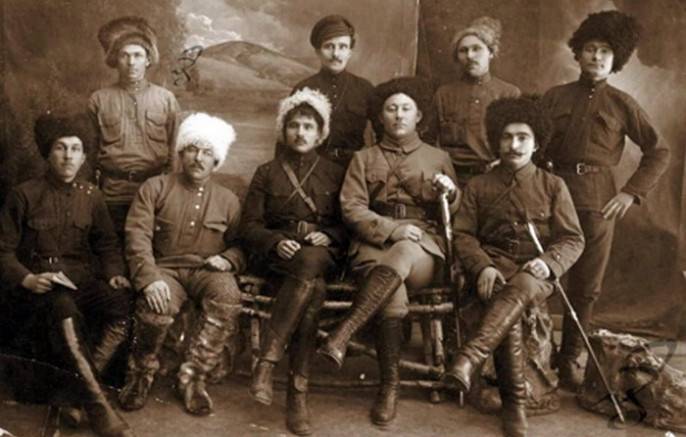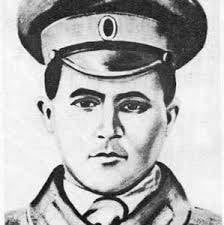"Red Eagles" of Altai. Guerrillas Rogov against Kolchak and the Bolsheviks
In the west, in the Ukraine, the center of insurgency was Gulyaypole, which turned into the capital of the Revolutionary Insurgent Army, the Natior Makhno fathers. The peasant movement developed in the Tambov region, in the Volga region, and in the east of the country, in the Altai, its own insurgent army was formed and successfully acted against the “Whites”. We know less about her than about the rebels of Makhno. Moreover, in Soviet times, the theme of the peasant insurgency of the Civil War did not appeal. The rebels were called “green” and actually equated to gangsters, sometimes mixing more with “whites,” although, speaking of Altai, it was the rebels who freed the region from “whites”, setting the stage for the establishment of Soviet power here.
The population of Altai and Siberia at the time of the events in question was divided into two main groups - the old-timers and the settlers. Old-timers, including the Cossacks, owned the main part of land and, by right of precedence, considered themselves to be a more privileged group of the population. In turn, the immigrants who arrived here from the European part of Russia, felt disadvantaged. This social polarization contributed to the spread of revolutionary sentiments among immigrants. The exiled Bolsheviks, Socialist Revolutionaries and Anarchists, as well as soldiers and junior officers who were returning from the fronts of the First World War, made a great contribution to this process.
The uprising, raised by the Czechoslovak Corps in the spring of 1918, became the starting point for the subsequent transition of most of Siberia under the control of anti-Bolshevik forces. At the same time, in the villages and cities of Altai, a rebel movement began to take shape, which at first set itself the task of self-organizing the peasants to fight the actions of the “white” and Czechoslovaks. Indeed, many “white” detachments not only fought with the Bolsheviks and sympathizers, but created real chaos, including purely criminal crimes against the peasant population.
 Quite quickly, in the rebel environment, their own commanders emerged, creating their partisan detachments and gaining great prestige among the peasants. Efim Mamedov at the time of the events described was only 29 years old. Coming from a family of peasant migrants, he lived in the village of Vostrovo (Kabanye) of the Pokrovsky volost, which was part of the Slavgorod district of the Tomsk province (today it is Volchikhinsky district of the Altai Territory), and received his primary education.
Quite quickly, in the rebel environment, their own commanders emerged, creating their partisan detachments and gaining great prestige among the peasants. Efim Mamedov at the time of the events described was only 29 years old. Coming from a family of peasant migrants, he lived in the village of Vostrovo (Kabanye) of the Pokrovsky volost, which was part of the Slavgorod district of the Tomsk province (today it is Volchikhinsky district of the Altai Territory), and received his primary education. In 1910, Mamontov was called up for military service, and he returned home only seven years later. Mamontov served as a telegraph operator at the engineer battalion, and was sent to the front, where for bravery he received the St. George crosses of the 4 and 3 degrees. Returning from the war to his native Vostrovo, he quickly established contacts with local revolutionaries and was elected to the village council. When the anti-Bolshevik government was finally established in the province, Mamontov created a rebel detachment, where the peasants from Vostrovo entered. Mamontovtsy went to the aid of the rebels of the village of Black Dol. Although the Chernodolsk uprising was quickly suppressed, the Mamontov partisans continued to resist "white". Since the spring of 1919, the Mammoths fought a partisan struggle in the south of Slavgorod district, attacking wealthy peasants, merchants, forest guards.
Grigory Fedorovich Rogov was also a front-line soldier. He was born in 1883, in the village of Zhulanikha, Mariinsky volost, Barnaul district, where his parents - poor peasants - moved from the Tomsk province. Then Rogov was called up for military service, he participated in battles during the Russian-Japanese war, was awarded the St. George's Cross and received the rank of sergeant-major, which in itself was already very much for the soldier of the tsarist army. In 1907, Rogov returned from work, worked as a salesman in a wine shop

Despite the fact that Rogov had five children, in 1914, he was again drafted into the army and sent to the front. He served in the railway battalion, was promoted to ensign. In 1917, Rogov returned home and first joined the Social Revolutionaries, and after the October Revolution he supported the Bolsheviks. But in his political views, Grigory Rogov was even to the left of the Bolsheviks. Soon he began to declare himself as an anarchist. Anarchist position Rogov outlined and at the Kuznetsk Congress of Soviets.
In July, 1918, Rogov created a partisan group in his native Zhulanikha and soon formed on its basis a whole detachment, which joined the struggle against the Provisional Siberian Government, and then Admiral Kolchak. In the second half of 1919, under the command of Rogov, an entire guerrilla army of a total of thousands of people in 5 turned out to be in Prichumysh and managed to free 18 volosts on the right bank of the Ob from Kolchak.
One of the great victories of the Rogovites was the battle of Sorokino, where they managed to defeat a squad of 1500 fighters under the command of Lieutenant Romanovsky. In the area of Zyryanovka, the corneas defeated the Uhlan squadron of Ataman Annenkov, then in the village of Togul defeated the local white garrison, which numbered more than a thousand people.
The fame of Rogov and his fighters spread through the Altai very quickly. Many poor peasants treated the cornets as liberators, but numerous testimonies of the atrocities of the rebels remained. Rogovts mercilessly punished wealthy peasants and Cossacks - old-timers, killed priests, did not disdain to robberies of churches. Naturally, the Bolsheviks, who decided to put the formation of Rogov under control, soon turned their attention to such a significant force. In June, the Barnaul Committee of the RCP (B.) Sent 1919 Communists headed by Matvey Vorozhtsov to the Rogov Detachment. That is, in Altai, the line was also tested, which the Bolsheviks adhered to in the Ekaterinoslav region in relation to Nestor Makhno and his rebel army. Formally supporting Rogov, the Bolsheviks created their own cells behind him, village councils subordinate to the regional congress of Soviets under their control.

In the end, the policy of the Bolsheviks led to a sharply negative reaction from Rogov. He reacted to the actions of the Bolsheviks as well as the other rebel leader Makhno at the opposite end of the country. In early December, 1919, Grigori Rogov drove the Bolsheviks out of his squad, but the latter were able to carry a large part of the rogovskih fighters.
Gradually, Rogov began to treat the Bolsheviks no less negatively than the whites. Entered into history the famous capture by the cornea and the settlers of Kuznetsk. The city detachments gf Rogov and I.P. Novoselov entered 12 December 1919 of the year. Almost immediately, the “rogovian cleansing” began, as the inhabitants nicknamed three-day reprisals against all those whom the cornea considered enemies of the revolutionary working people. All Kolchak's officers, officials, policemen, priests, most of the merchants and kulaks were definitely subject to the death penalty. The buildings of the Transfiguration Cathedral and the Odigitrevskaya church, a city prison, were set on fire by the Rogovians. In total, during the "cleansing" at least several hundred people died. Now accurate data on the number of dead are unknown, but we are talking about about 400-700 residents of Kuznetsk.
Having managed for three days in Kuznetsk, the corneses left the city and moved in two directions. One part went in the direction of Kolchugino, another - in the Biysk and Barnaul counties. It should be noted that the Kolchakites, who eventually managed to press the corneses, behaved no better, or even worse, than the peasant rebels. Kolchak detachments continued to rob and rape the local population, and they also killed any citizens and peasants who seemed suspicious to them.
Meanwhile, a little more than a week after the capture of Kuznetsk, namely 21 of December 1919, the corneas were able to knock out an entire infantry regiment of Kolchak's army from Shcheglovsk with a lightning strike. Then the squad of Rogov joined the battle with Kolchak in the area of the station Topki, but, having lost about a hundred soldiers, the rebels were forced to retreat. In the meantime, the Bolsheviks intervened. 25 December 1919 of the year came the order of the Revolutionary Military Council of the 5 Army, that Rogov and his unit join the 35 Division. The chieftain, naturally, refused such an offer and 29 of December 1919 of the year was arrested by the Reds. He was transferred from Shcheglovsk to Kuznetsk, then to Novonikolaevsk, but in February 1920 was released with full rehabilitation and paid 10 thousand rubles in compensation and recognition of his revolutionary achievements.
The Bolsheviks tried to persuade Rogov to join the RCP (b), knowing full well that the authority and abilities of the peasant commander could still serve them well. But Rogov, who was an ideological anarchist, refused the proposal of the Bolsheviks. He returned to the village of Zhulaniha, where he tried to create a “true working commune”.
After recovering slightly from prison, Rogov again tried to assemble a rebel detachment. 4 May 1920, he appeared in the village of Togul, where he attacked with his supporters at the local Soviet institutions, defeated and robbed them. In the footsteps of Rogov was sent to the Red Army detachment. Fearing torture and bullying in case of being captured, 3 July 1920, Grigory Rogov, who was at that time in the village of Evdokimovo in the Dmitro-Titov Volost, shot himself. However, there is another version - the field commander was allegedly shot by the chairman of the local party cell Poletayev, to whom Rogov, who had spent the night in the barn, was given out by one of the local peasants.
The renowned chieftain was buried in the village of Khmelevka in a mass grave, and on October 20 2007, 87 years after his death, in Khmelevka opened a memorial plaque in memory of Rogov as one of the notable historical figures of the Altai during the Civil War. The tragic figure of Grigory Rogov reminds us of that terrible time when brother raised weapon against the brother, and the simple civilians suffered the most.
Similarly, the fate of Efim Mamontov. Back in October 1919, he was elected commander-in-chief of the West Siberian Peasant Red Army. In the best time in the army, there were 18 thousands of fighters, brought together in regiments and troops. The most combat-ready, “elite”, as they would say now, was the 1 th Peasant rebel regiment “Red Eagles”.
 They were commanded by Fyodor Efimovich Kolyado - a very young 20-year-old guy who came from a family of immigrants. In 1916, he was called up for military service. In October 1917, Kolado deserted and soon joined the partisans, where, as a man with a military background, he quickly moved into the rebel commander's regiment. In November, 1919, Kolad died in the Solonovsk battle, during which the rebel army clashed with Kolchak. That battle ended in a crushing defeat of Kolchak, but the rebels suffered serious losses.
They were commanded by Fyodor Efimovich Kolyado - a very young 20-year-old guy who came from a family of immigrants. In 1916, he was called up for military service. In October 1917, Kolado deserted and soon joined the partisans, where, as a man with a military background, he quickly moved into the rebel commander's regiment. In November, 1919, Kolad died in the Solonovsk battle, during which the rebel army clashed with Kolchak. That battle ended in a crushing defeat of Kolchak, but the rebels suffered serious losses. Under the command of Mamontov 6-7 in December 1919, the rebels tried to storm Barnaul, but their attacks were repelled by the enemy’s artillery. However, on the night of December 10 1919, White nevertheless left Barnaul. When Soviet power was restored in Altai, Mamontov was appointed an assistant to an inspector of infantry of the 5 Army, then head of the spare parts supply department of the 5 Army. Unlike Rogov, the Mammoths were more compliant with the red ones, but this did not help him. Despite the fact that from June to September 1920, Mamontov was the commander of the First Separate Red Volunteer West Siberian Rifle Brigade, fought against the Wrangel, then commanded the brigade as part of the 27 Infantry Division of Internal Service Forces, December 25 1920, he was arrested by the Cheka in Barnaul. Mamontov was then released, but 25 or 27 in February of 1922, he was killed in the village of Vlasikha near Barnaul.
The exact circumstances of the assassination of the former rebel commander are unknown. There is a version that he, like Rogov, fell victim to agents of the OGPU, who were cracking down on uncontrolled and unreliable former partisan commanders. The Soviet government was very afraid of such people - "violent" front-line soldiers, field commanders who enjoyed great prestige among the revolutionary peasantry and had personal merits in the struggle against the "whites." After all, many of these commanders have never concealed their disagreement with Bolshevik politics, considering it to be an attack on the interests of the working peasantry, then still the main majority of the Russian population.
Even those of yesterday’s partisans who were lucky enough to survive the Civilian years, still ended their lives tragically. Thus, one of the associates of Mamontov, anarchist communist Mikhail Sidorovich Kozyr was arrested in 1930 year and shot in Tobolsk. Alexander Andreevich Neborak, who replaced Kolyado at the head of the rebel regiment, then served in the Red Army, taught at the military academy, during the Great Patriotic War he was appointed commander of the 253 Infantry Division as a brigade commander. But because of the conflict with the military commissar, Neborak was removed from office and shot himself.
Information